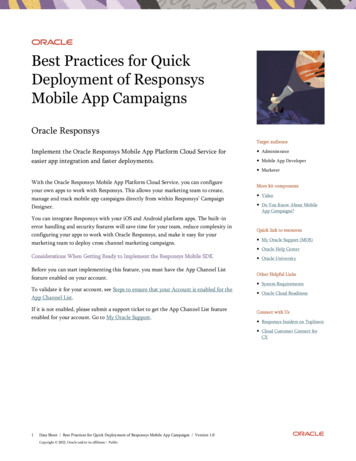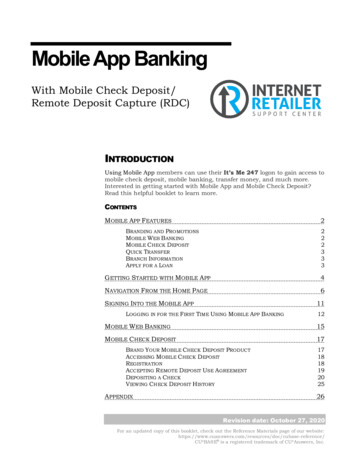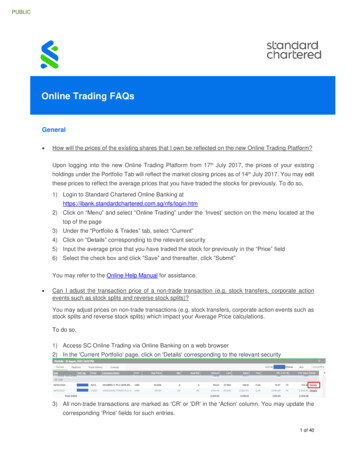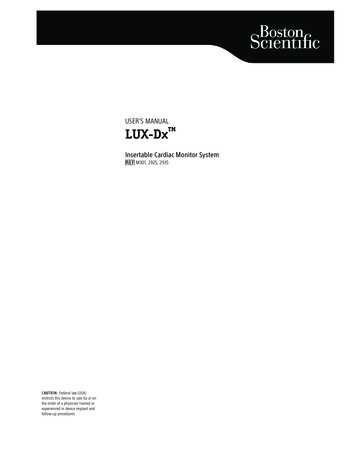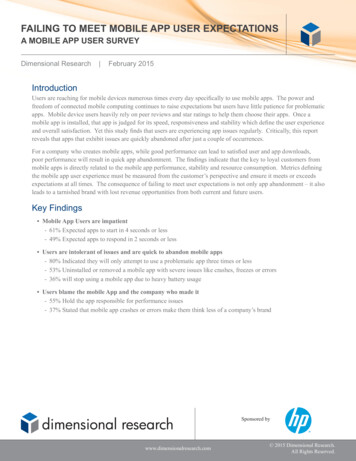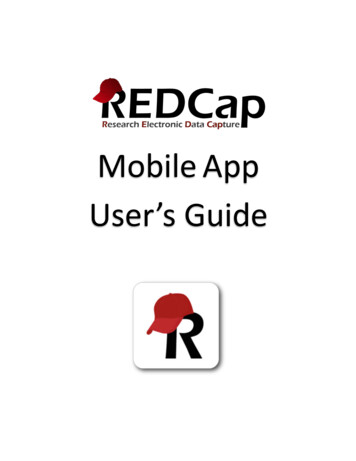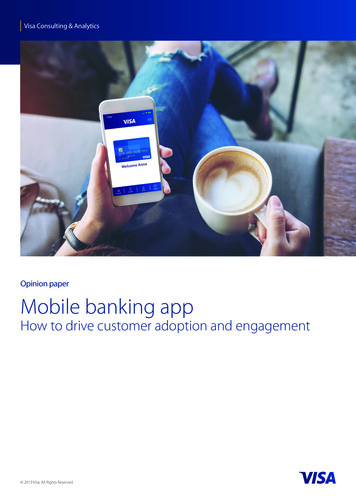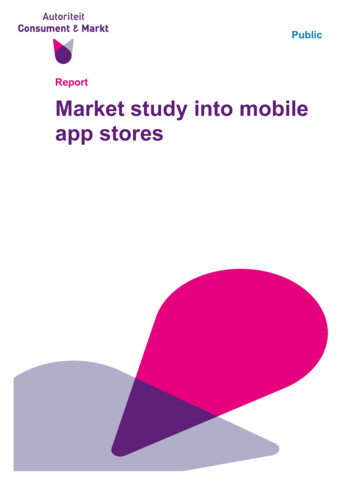
Transcription
PublicReportMarket study into mobileapp stores
The Netherlands Authority for Consumers & MarketsMarket study into mobile app storesPublicCase no.: ACM/18/032693 / Date: 11 April, 2019Table of contentsExecutive The app-ecosystem19Importance of the app 3.33.43.53.63.74.14.24.3Reason for looking into mobile app storesACM’s perspective, public interests and the scope of this reportMethodology and structure of this reportOnline PlatformsThe consumerApp providersThe app ernatives to appsAlternatives to app storesAlternative app-ecosystemsBargaining PowerFuture DevelopmentsObservationsEqual access to the end-userIn-app purchasesTransparency & lic interests101Findings and follow-up106Annex 1: Contacts (confidential)10965.15.26.16.26.36.4Competitive marketsSafeguarding consumer interestsFavouring own apps over apps from other providersUnequal treatment of apps in generalLack of transparencyFollow-up1011041061071071082/109
The Netherlands Authority for Consumers & MarketsMarket study into mobile app storesPublicCase no.: ACM/18/032693 / Date: 11 April, 2019Executive summaryFor a Dutch version of this executive summary, see the next chapter.In this market study, ACM analysed to what extent Apple and Google have the incentive and theopportunity with their app stores to influence the availability of apps and the functioning thereof. ACMtherefore studied the relationship between app providers and mobile app stores.Reason and perspectiveThe smartphone has become increasingly important. The Dutch consumer uses the smartphone moreand more to access content and services on the internet. This is mostly done through apps. Apple andGoogle both have attained strong positions on this market with their operating systems (iOS andAndroid respectively) and accompanying app stores (the App Store and the Play Store respectively).Since the vast majority of Dutch consumers is only accessible through one of these channels, it isimportant to have an app present in both app stores for companies that want to reach every Dutchconsumer with a smartphone.Apple and Google determine and control what apps are available in their respective app stores. Theyare able to do so by setting the terms and conditions for their app stores, by determining whatfunctionalities are available to app providers to utilize and to decide how apps are ranked and featuredin the app stores. In that way, Apple and Google also have the opportunity to influence the availabilityand functioning of apps since they control the mobile operating system. App stores are thus theentities guarding the selection for and presentation of apps to consumers.Since 2016, Internet Service Providers are, under the Net Neutrality Regulation, prohibited to treatsimilar Internet traffic differently. In short, the Regulation addresses ISPs to keep open the broadbandconnection between, on the one hand, the equipment of end-users, such as a smartphone, and, on theother hand, providers of digital services and content. The Open Internet Regulation does not directlyaddress online platforms such as app stores. However, given the growing importance of app stores forapp providers in order to reach end-users on their smartphone, it could be questioned whether appstores have the opportunity to restrict end-user rights effectively.The growing importance of app stores in combination with the purposes of the Net NeutralityRegulation is the reason why ACM conducted this market study. ACM first analyses the app storeecosystem and the importance hereof. ACM also studies how the process of approval, selection andmanagement of an app is done, of both own apps and third-party apps, and what influence thisprocess has on what apps are available to end-users. Subsequently, ACM investigates in this marketstudy how these findings and reports about the conduct of Apple and Google might influence publicinterests. ACM analyses the public interests that come with the mission of ACM as a market authority:‘competitive markets’ and ‘safeguarding consumer interests’. Finally, ACM will establish which of theidentified practices might call for further investigation.The app-ecosystemThe iPhone was the first smartphone, brought to the market in 2007. This smartphone wascharacterized with an operating system (iOS), with the ability to install apps on the iOS. One year later,Google launched its operating system Android. The launch of smartphones has therefore led to therise and massive growth of online platforms. These platforms facilitate and organize online interactionsbetween users and suppliers. Most of these interactions run through apps. Both Apple and Google3/109
The Netherlands Authority for Consumers & MarketsMarket study into mobile app storesPublicCase no.: ACM/18/032693 / Date: 11 April, 2019enable third-party software developers to develop and offer apps for Google’s Android and Apple’siOS. Consumers can access these apps by downloading them from an app store. App stores allowusers to discover, install, update, and remove applications from their devices. Which app store isavailable, depends on the operating system. The Play Store is the primary app store installed onAndroid devices. The App Store (hereafter: App Store) is the only app store available for iOS. In theNetherlands, approximately 30-45% of the smartphones run on iOS, and 55-70% of the smartphonesrun on Android. In the app stores, both own aps and third-party apps are offered. The Play Storeoffered in total 3.3 million different apps, the App Store 2.2 million.By opening up their platform to third-party app providers, Apple and Google activated indirect networkeffects effectively: the more apps in the app stores, the more consumers come to the platform, themore attractive the platform gets for app providers, etc. This increased the value of the products andservices of Apple and Google. This effect increased as a result of smartphone producers that alsochose for certain operating systems. So the success of Google and Apple’s app stores comes partlyfrom an integrated environment (smartphone, mobile OS, app store, apps) that enabled the app storesto profit fully from indirect network effects and reach scale.Though both ecosystems opened up to app providers, both ecosystems are still closed enough toguarantee the quality of the app-ecosystem. This was and is mainly possible due to the control Appleand Google hold over their ecosystems. The lack of control is also the reason why Symbian andWindows lost this race against Apple and Google. For Apple, vertical integration turned out to be animportant strategy to maintain control and guarantee the quality. For Android, bundling of APIs with thePlay store cause Google to control their app-ecosystem.Google and Apple have very different business models and thus different motives. Apple highlights theimportance of privacy and security, while Google promotes their more open ecosystem and lowerpriced and even free services. But, even though they differ in many aspects, the app stores areessential for both Apple and Google to maintain control over their ecosystem. Also, they have thesame goals with the app stores, namely attracting as many consumers as possible into theirecosystems to fuel their business models.Most app providers are dependent on the app stores to reach their public. Apple and Google are bothin a position to decide whether an app is available in the app store and how this app can reach itspublic.Importance of the app storeACM assessed whether the app stores and/or the app-ecosystems form a bottleneck within the appecosystem. This is analyzed by assessing whether there are viable alternatives available for apps andthe app stores. It turned out that the browser or web-apps cannot be considered as a realisticalternative to most native apps since their functionality and usability is limited compared with nativeapps. It is also a lot harder to reach an audience with a web app since there is no central distributionpoint where consumers come to search for web-apps.A possible realistic alternative to the app store is sideloading. Sideloading refers to the installation ofapps on a smartphone without using the app store. For consumers, sideloading is not possible on iOS.Sideloading might be a realistic alternative on Android, but only for apps that already have a largebrand awareness and established user bases.4/109
The Netherlands Authority for Consumers & MarketsMarket study into mobile app storesPublicCase no.: ACM/18/032693 / Date: 11 April, 2019On Android, it is also an alternative to install a different app store, for example the Amazon App Store,Aptoide or Samsung Galaxy apps. Consumers are then able to download apps from this alternativeapp store. But, these app stores cannot offer the same options as the Play Store. These apps can, forexample, not be updated automatically.Another option to circumvent the app stores is pre-installing apps on Android smartphones, alsoreferred to as pre-loading. This is usually accompanied by a fee. Since smartphone manufacturersgenerally prefer not to ship their devices with a large amount of third-party apps, pre-loading is usuallyreserved for a selected few, and are therefore very costly.Within the iOS-ecosystem, there are no realistic alternatives for apps or the App Store, so the AppStore forms a bottleneck within the iOS-ecosystem. Within the Android-ecosystem, some alternativesfor apps and the Play Store exist, but only for app providers that already have achieved a certainamount of brand awareness.The closed nature of both app-ecosystems cause high switching barriers for consumers but alsocauses high costs for app providers to offer their app in both ecosystems. Apple and Google mightcompete for app providers; but the popular and successful apps are present in both appstores. It isabout becoming a default gateway for consumers to reach online content, and for providers of contentto reach an audience. The app stores and their surrounding ecosystems form a very important basefrom which Apple and Google can expand their platform-ecosystem and secure the bottlenecks theyhave already captured.Apple and Google have a large amount of bargaining power over app providers. Towards very largeapp-providers, this might be less.ConductTo get insights into the approval and selection processes of the app stores, ACM interviewed severalapp providers, received written input and spoke to Apple and Google. Furthermore, ACM studied thegeneral terms & conditions of both Apple and Google and conducted a desk research to use the manydigital sources that are available about this subject. All of this input combined gives insight into theconduct of Apple and Google as controllers of the App store and the Play Store, respectively.App providers have remarks on the conditions on which access is granted and refused. App providerscomplain that the terms and conditions for access, especially for Apple, are open for multipleinterpretations and that the reasons given for a refusal can be unclear. App providers experienceproblems with the interoperability with the operating system of with functionalities on the phone, likewith Siri or the NFC-chip. Other app providers have indicated that even though their apps are given fullaccess to the app stores they have a strong disadvantage compared with proprietary Apple andGoogle apps, due to the pre-installation of their own apps. Furthermore, app providers indicate that it ishard and/or expensive to be found by consumers.Secondly, the commission levied by Apple and Google leads to complaints by app providers. When anapp provider sells digital content or services in their app, they are required to use in-app purchases(IAP). Only apps that sell digital content that is delivered on the phone need to pay the commission: forexample Spotify, Netflix, premiums in a game or subscriptions to a newspaper. For an Uber ride or apackage from Bol.com, the use of IAP is not required. On these IAPs, the provider needs to pay a 30%commission, and 15% in the second year in case of a subscription. It is not allowed to link to paymentmethods outside of the app. App providers question the high fee percentage of the commission5/109
The Netherlands Authority for Consumers & MarketsMarket study into mobile app storesPublicCase no.: ACM/18/032693 / Date: 11 April, 2019(especially in the case of subscription services), and the distinction between those apps that do and donot have to pay the commission over in-app purchases. On top of that, app providers state that whenthey use IAP, there is an inability to access customer data and consequently to offer the right level ofservices to customers.Finally, app providers experience limited transparency & liability of Apple and Google. App providershave indicated that it can be difficult to get in touch with Google and Apple. In other cases,communication on rejections refer to vague terms & conditions, which makes it hard for app providersto adjust their apps. It is, especially for smaller and mid-size app providers, hard to get in touch withApple and Google. Most often, it is not possible to communicate with Apple and Google about therefusal of an app. This not only leads to a delay for the app provider, but this also might damage thereputation of an app provider and might be very costly. Furthermore, Apple’s terms and conditionsallow them to imitate (Sherlock) apps in their store and shift all liability to app providers. App providerscannot do anything else but accept these terms & conditions.ACM also spoke to Apple and Google and ask them about their views on certain topics, the used terms& conditions and several processes. Apple and Google point at matters as integrity, safety and thequality of the app stores and the ecosystems, the investments they made to develop the app storesand the opportunities the app stores give to app providers. According to Apple, favouring their ownapps over third-party apps would not be rational. Apple wants to offer the best services possible to itsusers and therefore has no incentive to refuse a third-party that offers a higher quality app.Public interestsSubsequently, ACM examined how the importance of the app store and the conduct, have influence onpublic interests. Specifically, the public interests of well-functioning markets and consumer protectionare affected.The combination of effective competition and innovation on a market ensures that end-users get theoptimal combination of price and quality considering their personal preferences. However, wellfunctioning markets go beyond competition in the short run. When assessing effects on markets, ACMalso takes the long-term effects on consumer welfare into account.The app stores have greatly decreased entry barriers and have led to a flourishing of a variety ofinnovative apps. Google and Apple also safeguard the integrity and safety of their ecosystems, whichbenefits Apple, Google, app providers and consumers. By providing a development framework for appdevelopers, Apple and Google have promoted innovation within their respective ecosystems and havefacilitated the access to mobile consumers. The app stores have become a marketplace in their ownright and are able to influence the access that app providers have to the platform and ultimately,mobile consumers. The app stores also made it easier for an app provider to reach the consumer and,the other way around, for the consumer to access online content and services . As a result, transactioncosts between the app provider and consumer have decreased substantially.At the same time, Apple and Google have a unique role since they simultaneously fulfill the role of boththe app store operator and of the app provider. They may distort competition by limitinginteroperability, complicating access or limiting the favorable displaying of third-party apps, thusdisturbing equal access to the market. Several app providers that ACM interviewed gave examples ofsuch conduct. Certain limitations within the ecosystem may be justified and actually benefitconsumers, but this might limit the ability of app providers to offer certain services.6/109
The Netherlands Authority for Consumers & MarketsMarket study into mobile app storesPublicCase no.: ACM/18/032693 / Date: 11 April, 2019We have also seen that some app providers do not have access to all the customer data they wish tohave. This might impact the ability of the app provider to compete. Google and Apple have alsosignificant discretion over the presentation of apps. Both may determine how to rank apps and whatapps to feature.To conclude, the 30 or 15 percent commission levied by Apple and Google may also affectcompetition. This distortion of competition is present when Apple and Google apply the terms andconditions, related to the mandatory use of IAP, differently to similar apps. The competition betweencategories of apps may be distorted as well. Apps that fall outside the category of digital content andservices are favored in respect to apps that do fall within this category.The public interest of consumer protection can be characterized by consumers who have options tochoose from and who are able to make well-informed decisions. But consumers also benefit from highquality, safe products, and from their data being protected safely.Consumers greatly benefit from the app stores. App stores make it easily accessible and convenientfor consumers to reach and download apps on their mobile device. The large number of apps availablein the app stores can lead to the discovery of new products, content and services. But the largenumber of apps can also lead to increased search costs. The app stores aim to reduce this problem ofinformation overload by using algorithms and consumers rely on this. However, these algorithms arenot transparent and affect consumer choice.App stores have the incentive to have as many qualitatively good apps in the app stores as possible togrow the overall value of their ecosystem, which is beneficial for consumers. Consumers thereforebenefit from a strict review process. However, this review process causes that apps with certaincontent is not available in the app store. For example, erotic content is prohibited by both app stores.Consumers benefit the IAP system of Apple and Google. This increases the convenience forconsumers: a consumer only has to enter their payment details once, and can thereafter pay with justone simple click, and it prevents sensitive data from going to third-party app providers that might nottreat this data with care. On the other hand, the requirement to use IAP for certain apps may limitconsumer choice: consumers are restricted to the payment systems chosen by Apple and Google.Furthermore, when app providers that are required to use IAP, remove the IAP option completely (e.g.Netflix and Spotify), consumers are affected because certain app functions are no longer available.There are also examples where the app provider fully passes on the 30% commission to theirconsumer prices, which negatively impacts consumers as well.Findings and follow-upIn this market study, ACM received several reports from app providers about the conducts exhibited byApple and Google. Given the important position of Apple and Google with their respective app storesand the public interests that might be at stake, ACM has identified three types of conduct that mightwarrant further investigation.First, ACM has an indication that Apple and Google might favour their own apps over apps fromcompeting app providers. Second, app providers have raised the issue that comparable apps aretreated differently in some instances. Third, ACM has received reports from app providers that Googleand Apple are not transparent in their communication. The upcoming Platform to Business regulationmight form a solution to this problem.7/109
The Netherlands Authority for Consumers & MarketsMarket study into mobile app storesPublicCase no.: ACM/18/032693 / Date: 11 April, 2019Further investigation might be done by exploring options for ex ante regulation, for example byadditional regulation, similar to the European Open Internet Regulation. Further investigation may alsobe conducted under existing legislation, such as competition law. ACM is of the opinion that thefindings of this market study warrant further investigation, based on either one of these legislativeinstruments.8/109
The Netherlands Authority for Consumers & MarketsMarket study into mobile app storesPublicCase no.: ACM/18/032693 / Date: 11 April, 2019ManagementsamenvattingIn deze marktstudie heeft de ACM onderzocht in hoeverre Apple en Google, met hun appstores en deprikkel en mogelijkheden hebben om invloed uit te oefenen op de beschikbare apps in de appstores enop het functioneren van deze apps. De ACM heeft hiertoe onderzocht hoe Apple en Google omgaanmet appaanbieders die een app in een appstore willen plaatsen.Motivatie en perspectiefDe smartphone is over de afgelopen jaren steeds belangrijker geworden. De Nederlandse consumentgebruikt de smartphone steeds meer om services en content op het internet te bereiken. Dit doet zijvooral door middel van apps. Apple en Google hebben beiden een zeer sterke positie verworven methun besturingssystemen (respectievelijk iOS en Android) en bijbehorende appstores (respectievelijkde App Store en de Play Store). Aangezien de Nederlandse consument voor het overgrote deelslechts bereikbaar is via één van deze twee kanalen, is het voor een aanbieder die alle Nederlandseconsumenten op zijn mobiele telefoon wil bereiken, noodzakelijk om in beide appstores aanwezig tezijn.Apple en Google beslissen en controleren welke apps er in de respectievelijke appstores aanwezigzijn. Zowel door het stellen en toepassen van voorwaarden voor het publiceren van een app, hetbeschikbaar stellen van functionaliteiten voor apps, als het ranken en uitlichten van apps in deappstores. Daarnaast hebben Apple en Google de mogelijkheid om invloed uit te oefenen op debeschikbaarheid en functionaliteiten van apps door hun controle op het mobiele besturingssysteem.Apple en Google beschikken hierdoor mogelijk over een poortwachterspositie.Sinds 2016 is het onder de Europese netneutraliteitsverordening niet toegestaan voorinternetaanbieders om vergelijkbaar internetverkeer technisch verschillend te behandelen. Dezeverordening zorgt ervoor dat internetaanbieders de breedbandverbinding open houden tussenenerzijds de apparatuur van eindgebruikers, zoals de smartphone, en anderzijds de aanbieders vanonline diensten of content. Platformen zoals appstores vallen als zodanig niet onder deze regulering.Maar gezien het toenemende belang van de appstores in het gebruik van mobiel breedband dooreindgebruikers, kan de vraag worden gesteld of appstores effectief de mogelijkheid hebben omeindgebruikersrechten te beperken.De ACM is deze marktstudie gestart vanwege het vooronderstelde belang van de appstores in demobiele wereld bezien in combinatie met de gedachte achter de Europese netneutraliteitsverordening.De ACM analyseert allereerst het appstore ecosysteem en het belang hiervan. Tevens onderzoekt deACM hoe het proces van goedkeuring, selecteren en managen van apps er uit ziet, zowel van eigenapps als apps van derden, en welke invloed dit proces heeft op de apps die beschikbaar zijn vooreindgebruikers.Daaropvolgend onderzoekt de ACM in deze marktstudie hoe de bevindingen en signalen metbetrekking tot de gedragingen van Apple en Google de publieke belangen kunnen beïnvloeden. DeACM analyseert hierbij de publieke belangen die samenhangen met de missie van de ACM alsmarkttoezichthouder, te weten: ‘concurrerende markten’ en ‘behartigen van consumenten belangen’.Tot slot stelt de ACM vast of/en zo ja welke signalen en bevindingen nader onderzoek vragen.Het app ecosysteem9/109
The Netherlands Authority for Consumers & MarketsMarket study into mobile app storesPublicCase no.: ACM/18/032693 / Date: 11 April, 2019In 2007 lanceerde Apple haar eerste smartphone, de iPhone. Deze mobiele telefoon werd gekenmerktdoor een besturingssysteem (iOS) met een onderscheidende mogelijkheid om apps op het iOS teinstaleren. Niet veel later volgde ook de lancering van het besturingssysteem Android, dat wordtgecontroleerd door Google. De lancering van smartphones heeft (onder meer) geleid tot de opkomsten groei van online platforms. Met deze platforms worden interacties tussen aanbieders enconsumenten gefaciliteerd. Veel van deze interacties en services gaan door middel van apps. ZowelApple als Google hebben het gemakkelijk en laagdrempelig gemaakt voor app aanbieders om apps teontwikkelen voor Android en iOS. Consumenten kunnen deze apps downloaden, installeren, updatenen verwijderen via de appstore. Welke appstore beschikbaar is, is afhankelijk van hetbesturingssysteem. Op Android is de Play Store van Google de voornaamste appstore, deze wordtvooraf geïnstalleerd op de Android toestellen. Op de iPhone biedt Apple’s App Store de enigemogelijkheid om apps te downloaden. In Nederland is op ongeveer 30-45% van de smartphones iOSgeïnstalleerd, en op 55-70% Google-Android. In beide appstores worden zowel eigen apps als appsvan derden aangeboden. In totaal zijn dit 3,3 miljoen apps in de Play Store en 2,2 miljoen apps in deApp Store.Door hun platform open te stellen voor andere appaanbieders, hebben Apple en Google effectiefindirecte netwerkeffecten kunnen activeren: hoe meer apps in de appstore, hoe meer consumentennaar dit platform komen, hoe aantrekkelijker dit platform weer wordt voor appaanbieders, etc.Daarmee zijn de producten en services van Apple en Google in waarde toegenomen. Dit werdversterkt door de smartphone fabrikanten die ook voor een bepaald besturingssysteem hebbengekozen. Het succes van Apple en Google is daarom mede toe te schrijven aan de succesvolleintegratie van smartphone, het besturingssysteem, de appstore en de apps, wat de mogelijkheid gafom optimaal te profiteren van indirecte netwerkeffecten en een substantiële schaal te bereiken.Ook al hebben Apple en Google hun ecosystemen geopend voor app aanbieders, beide ecosystemenzijn wel gesloten genoeg om de kwaliteit van het app-ecosysteem te waarborgen. Dit komt door decontrole die Apple en Google over hun app-ecosysteem hebben. Dit is Symbian en Windows nietgelukt, doordat zij minder controle hadden. Hierdoor hebben zij het verloren van Apple en Google. BijApple is de verticale integratie van hardware en software een belangrijke strategie gebleken om dekwaliteit te waarborgen. Voor Android is dit de bundeling van API’s en met Play Store. Dit zorgt ervoordat Google de controle kan houden op zijn app-ecosysteem.Ook de bedrijfsmodellen van Apple en Google verschillen enorm. Waar Apple zich meer richt op hetbelang van veiligheid en privacy, is Google meer gericht op het verzamelen van data, wat ze doet doormiddel van een open ecosysteem met lage prijzen en gratis services. Maar, voor beiden is de appstoreeen essentieel onderdeel van hun ecosysteem en beiden hebben hiermee hetzelfde doel: zoveelmogelijk consumenten in hun ecosysteem krijgen.Appaanbieders zijn afhankelijk van de appstores voor het al dan niet slagen van een app. Apple enGoogle zijn in een positie om te bepalen of een app in de appstore komt en hoe deze weergevenwordt.Belang van de appstoresDe ACM heeft onderzocht in hoeverre de appstores een bottleneck vormen binnen het appecosysteem. Hiertoe heeft de ACM onderzocht of er realistische alternatieven zijn voor de appstoresen voor apps. Hier uit blijkt dat de browser of web-apps veel minder functionaliteiten bieden dan nativeapps en daardoor geen realistische alternatieven zijn. Bovendien zijn deze web-apps moeilijker tevinden voor consumenten, omdat er geen centraal distributiepunt is, zoals de appstore.10/109
The Netherlands Authority for Consumers & MarketsMarket study into mobile app storesPublicCase no.: ACM/18/032693 / Date: 11 April, 2019Een ander mogelijk alternatief is om apps via sideloading op de telefoon te installeren, hiermee wordtde appstore omzeilt. Sideloaden is voor consumenten niet mogelijk op iOS. Op Android zou dit weleen alternatief kunnen vormen, maar alleen voor apps die al een grote naamsbekendheid en een groteklantenkring hebben of voor hele technische consumenten.Op Android is het daarnaast mogelijk om, via sideloading, ook andere appstores te installeren, zoalsde Amazon Appstore, Aptoide en Samsung Galaxy Apps. Consumenten kunnen dan ook vanuit dieappstores hun app downloaden. Deze appstores bieden echter niet dezelfde mogelijkheden aan als dePlay Store. Zo kunnen apps niet automatisch worden geüpdatet.Appaanbieders kunnen daarnaast apps vooraf laten installeren op een Android smartphone, voor devoorinstallatie van apps dient in de regel betaald te worden. Omdat smartphone fabrikanten niet willendat er te veel apps voor geïnstalleerd worden, is dit in de praktijk erg duur.Omdat er op iOS geen realistische alternatieven voor de App Store zijn, concludeert de ACM dat deappstore een bottleneck vormt binnen het iOS ecosysteem. Op Android zijn er alternatieven, maardeze zijn alleen succesvol voor apps met een bepaalde grootte en bekendheid.Het gesloten karakter van beide ecosystemen zorgt voor hoge overstapdrempels voor consumentenmaar ook voor hoge kosten voor appaanbieders om hun app in beide ecosystemen aan te bieden.Apple en Google mogen dan met elkaar concurreren om appaanbieders: maar alle populaire ensuccesvolle apps zijn in beide appstores aanwezig. Het is Apple’s en Google’s doel de defaulttoegangspoort te worden voor consumenten om online content te verkrijgen. De appstores vormeneen belangrijke basis vanwaar Apple en Google hun ecosysteem kunnen vergroten en hunpoortwachtersfunctie kunnen versterken.Apple en Google hebb
Android devices. The App Store (hereafter: App Store) is the only app store available for iOS. In the Netherlands, approximately 30-45% of the smartphones run on iOS, and 55-70% of the smartphones run on Android. In the app stores, both own aps and third-party apps are offered. The Play Store
